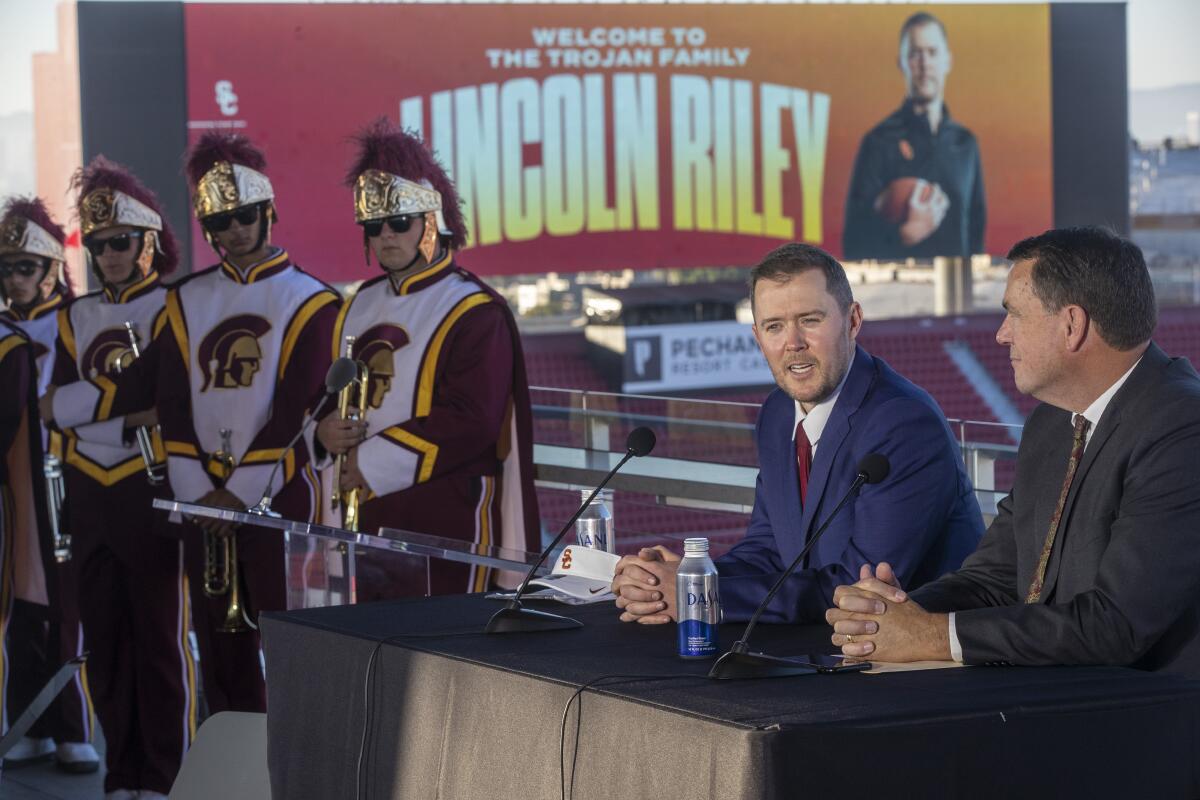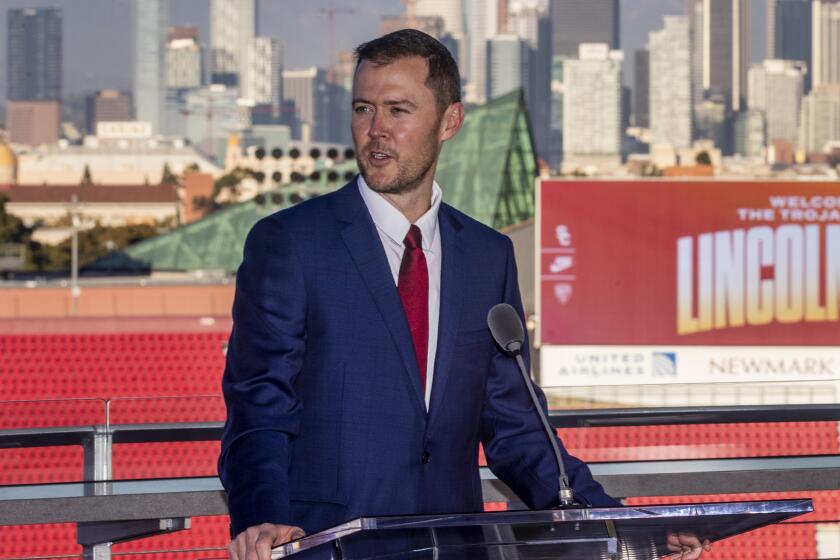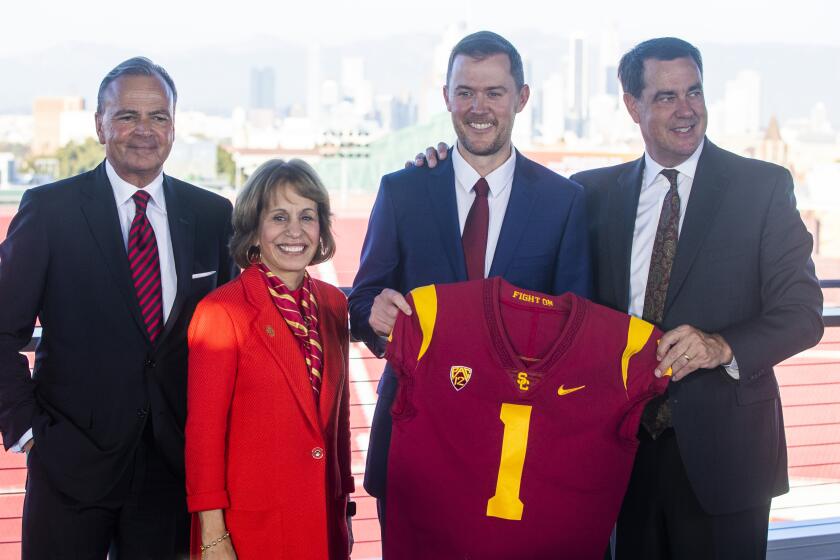Op-Ed: How can colleges afford to pay outlandish salaries to Lincoln Riley and other coaches?

- Share via
In recent days, college football coaches have been handed some of the most lucrative contracts the sport has ever seen. Lincoln Riley was hired by USC with a contract speculated to be worth $110 million. Brian Kelly was hired by Louisiana State University on a 10-year contract reportedly worth $100 million. At Michigan State, a coach who will not be vying for even a conference title will get a contract extension worth $95 million over 10 years, an amount he will receive in full if he is fired at any time without cause.
This is all possible, in significant part, because of the cap on the value of labor in college football. Simply put, players create the wealth in college sports but are only compensated in the form of scholarships. We are talking about one of the most egregious forms of systematic wage theft in American society today.
This “amateur” model of college sports yields $18.9 billion in annual revenue to universities and the NCAA, millions to coaches and athletic department officials, and essentially nothing to the athletes upon which the industry depends. The general counsel of the National Labor Relations Board, Jennifer Abruzzo, issued a memo in September stating that college players are employees under federal labor law and should be entitled to labor law protections, including the ability to negotiate fair wages and workplace rights.
During a 24-hour period, Lincoln Riley left Oklahoma for USC and Brian Kelly ditched Notre Dame for LSU. College football has turned a corner and isn’t coming back.
Needless to say, athletics department administrators have taken note. In a recent press release (which could be rightly described as “union-busting”) the organization representing athletic directors at Division I football programs nationwide stated that 85% of approximately 100 athletics directors surveyed said that they are “highly concerned about college athletes being classified as employees whether via legislative, administrative, or judicial means with possible corresponding benefits and protections such as the rights to organize, strike, overtime pay, minimum wage, health and safety protections, and more.”
Of course, these athletic directors benefit directly from the status quo. Four earn more than $2 million a year. Twenty-five earn $1 million or more, while 51 earn $700,000 or more. These numbers do not include athletic directors at a number of private universities.
Many players we’ve talked to are well aware of how they are being used. As one former Division I gymnast we interviewed puts it, “I honestly feel surprised that 15% of athletic directors put the athletes’ empowerment and health above their own self-interests.” She also points out, “How can athletes be denied the right that any self-respecting NCAA employee would insist upon for him or herself? What anthropology professor would ever agree to take a job that didn’t offer worker’s compensation or health benefits?”
Lincoln Riley brought swagger and several new staffers to his introduction as USC’s new football coach. He also promised to deliver results. Quickly.
Yet, athletes get no such protection or benefits despite working full time. Full-time employment is defined by the IRS as 30 or more hours worked in a week. Based on that definition and the NCAA’s own data, 19 different sports qualify as a full-time workload based on weekly hours worked. Notably, Division I football players work a median of 40 hours per week, while baseball players work even more at 42 hours.
The money thrown at failed or departing coaches is even more preposterous. Between Jan. 1, 2010, and Jan. 31, 2021, public schools in the top football conferences paid coaches in men’s and women’s basketball and football $533.6 million not to work. That number has only risen in recent months, with fired football coaches getting huge buyouts, including $16.9 million, $9.9 million, and $12 million at LSU, the University of Washington and the University of Florida, respectively.
For Danté Stewart, a former football player at Clemson, the position of athletic directors on college athlete employment rights cannot be divorced from the racial dynamics of college sport.
Notably, 83% of athletic directors in Division I are white, while athletes on men’s football and men’s and women’s basketball teams are predominately Black. In fact, Black athletes in the Power Five conferences are estimated to be losing out on $1.2 billion to $1.4 billion a year. “It’s a demonstration that college sport is a site of white male power,” Stewart says. “This is why I believe in unionization. Players have no one to defend their interests.”
This becomes particularly urgent in the context of occupational health and safety. While colleges sometimes cover costs for injuries caused by the sport, most athletes don’t receive health coverage for anything nonsports-related and none receive long-term coverage for health problems stemming from their time in college sports. Questions of health and safety are also compounded for players by the precariousness of their employment status. Scholarships generally need to be renewed yearly, which means issues with mental health or other injuries are often ignored or hidden for fear of losing scholarships.
What does this all mean moving forward?
“The reality is the NCAA system operates like professional sports,” says Brittany Collens, a former tennis player at the University of Massachusetts. “There can be a fair system that works for both athletes, schools, and athletic departments. It just requires effort and the right people behind it.”
There’s no reason to believe that those people are the athletic directors and football coaches currently living large on the uncompensated labor of the very college athletes they are charged with serving. But those athletes are not likely to tolerate having their interests denied and their voices silenced indefinitely. Time is running out.
Nathan Kalman-Lamb is a lecturing fellow in the Thompson Writing Program at Duke University. Derek Silva is an associate professor of sociology at King’s University College at Western University. Johanna Mellis is an assistant professor of history at Ursinus College. Together they host The End of Sport podcast.
More to Read
A cure for the common opinion
Get thought-provoking perspectives with our weekly newsletter.
You may occasionally receive promotional content from the Los Angeles Times.












